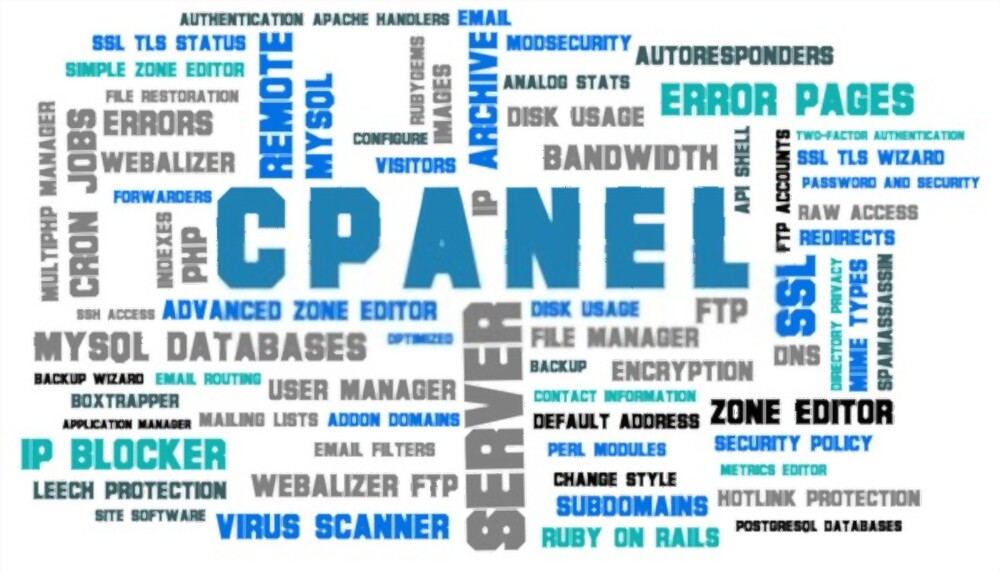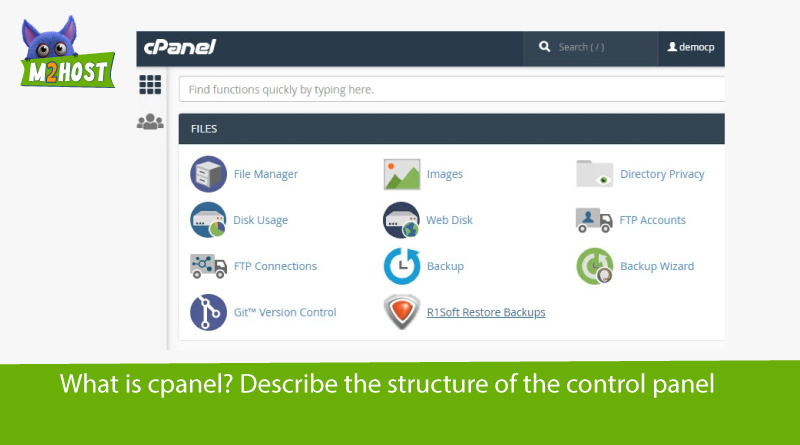Cpanel means what?
Cpanel is a Linux-based control panel with an intuitive GUI. Providing a human-friendly interface for managing your hosting settings, Cpanel simplifies maintaining your website.
Cpanel, among the most common control panels, is used by 11.8% of the total of all websites. Most low-cost shared hosting providers offer cPanel as a basic solution. In addition to managing domains, websites, and email accounts, cPanel also allows you to manage your website’s files and directories. Importantly, you don’t need special programming abilities or technical know-how to accomplish this.

Explain how Cpanel works?
cPanel is included in most hosting packages. This makes cPanel the standard; if a new host utilizes cPanel, you won’t have any trouble adapting, despite the fact that the interface may seem slightly different from the one you’re used to.
Cpanel has a lot of useful features, it’s simple to use, and it’s been tried and tested. Plus, you can control all aspects of your web hosting from one location, which saves time and effort.
Logging into your cPanel account will get you access to various features and statistics, including storage space utilization, file management tools, domain management, security settings, and more. In a nutshell, cPanel allows you complete command over your website with minimal effort.
When asked, we typically advise our readers to go with cPanel as their website management tool of choice. However, it is not without flaws, so let’s take a look at some of them.
Utilizing cPanel can have both positive and negative effects on your website.
Pros
- Easy to pick up
- User-friendly and logically constructed
- General Practice
- Features a single-button interface for installing programs
- Numerous users and advocates
- Some users may feel overwhelmed by the abundance of available capabilities.
- There is a risk that crucial configurations will be altered inadvertently.
- The software on certain hosts is out of date.
Functions of the Cpanel
Cpanel is segmented into sections that correlate to various facets of server and website administration.
The following are the elements that stand out the most among these:
Data management
Using a content management system (CMS) to create and maintain your website means that posts, plugin settings, and other data will be saved in a database. You can control your content management system databases from this portion of cPanel. Inherent in all of them are
- Server-Side MySQL Databases
- PhpMyAdmin
- A Guide to the MySQL Database Wizard
- Distant MySQL
Auto-installers
Most web servers will have a selection of commonly used scripts available for instant installation. These scripts are commonly stored in a folder labeled Auto-Installers, App Installers, Softaculous, or something similar. Common examples of auto-installation scripts are:
- WordPress
- Drupal
- Joomla
- PhpBB
Email Administration
CPanel’s Email section is where you’ll find tools for managing your email accounts, including creating new ones with your domain name, accessing your inbox, and more. Inherent in all of them are
- Encryption
- Autoresponders
- Respond to the Importer
- Parcel Delivery Optimization
- Forwarders
- Disk Space
- World-Wide Screening Devices
- Modifications Made By the User
Domain Administration
Domain-specific tools, such as those for adding a new domain (like shop.com), creating a new subdomain (like blog.shop.com), and setting up redirects, are all accessible from this section. Inherent in all of them are
- Domain Name System Administrator
- Supplemental Websites
- Aliases
- Subdomains
- Website Sneak Peek
- Redirects
Director of Files
The File Manager provides access to and control over all of your website’s files. While file transfer protocol (FTP) clients exist, cPanel offers a web-based interface that makes uploading and managing files much easier for newcomers. Included in the File Manager’s standard repertoire are the following:
- Safeguarding Your Website Regularly
- Storage Space Utilization
- Manager of Files
- File Transfer Protocol
- Images
- Version Control with Git
- Attributable to the I node Counter
Metrics
Daily monitoring is a need. The Metrics subsection is meant to help bridge the gap. With this data at hand, you can make educated choices about how to increase user engagement and boost conversions. Inherent in all of them are
- Bandwidth
- Awstats
- Multiple Users Accessing Online Services at Once
- How We Use Our Central Processing Units
- Visitors
- Total Unfiltered Access
- Errors
Security
You should be worried about safety if you aren’t already. Taking precautions to protect your website is crucial in light of the rapidly growing amount of viruses, malware, and other dangers. This is especially true for online stores that deal with money. You’re in luck, though, because cPanel offers a Security feature that can assist you. Inherent in all of them are
- Limiting Access to Websites with an Internet Protocol Blocker
- Let’s Encrypt! For SSL/TLS
- Security for Hotlinks
- Obtaining Secure Shell Access
- Anti-Leech Clothing
- A Two-Step Verification Process
Is cPanel Available on Any Web Hosts?
There are a lot of web servers that offer Cpanel, but it’s important to pick the correct one for your site, as we explained. The following are some of the best cPanel web hosts, in our opinion:
Myresellerhome
To help businesses of all sizes take control of their digital properties, we provide a user-friendly and low-cost cPanel hosting service. Our all-inclusive platform provides you with a unified interface for controlling your server infrastructure and websites. Our staffs of experts are here to serve you. You can choose from a variety of hosting plans tailored to your specific requirements, and our support staff is accessible 24×7 to answer any questions you may have about using your cPanel account.
Web hosting world
Our affordable Cpanel hosting solution is ideal for companies of all sizes. We have several different hosting options to choose from, and our professionals are accessible around the clock to assist you in getting your account set up and running. Trustworthy and secure, our cPanel hosting solution also comes with a plethora of extras to help you create an experience that’s all your own. We realize that each customer’s hosting requirements are different, which is why we provide a wide variety of services and customization choices.
M2host
When it comes to cPanel servers and hosting, M2Host is your number one choice. With over a decade in the industry, we know what it takes to deliver the best cPanel hosting service possible. With cPanel, you may choose from a wide range of hosting services, from basic shared hosting to high-end dedicated servers. We offer a multitude of cPanel services, such as an in-built web server, email management, limitless disc space, and many others. If you’re having trouble with cPanel, our staff of knowledgeable administrators is here for you around the clock. In addition to our other services, we provide round-the-clock assistance via phone, email, and live chat. M2Host is the best supplier for you whether you need a basic shared hosting plan or a fully featured dedicated server. Get in touch with us right away if you’re interested in our cPanel hosting packages.
How to access the Cpanel dashboard
Happily, the cPanel control panel is typically very user-friendly right off the off. In addition to being linked to the initial login page, most web providers will also include a direct link to cPanel in your initial welcome email.
If your web host isn’t as accommodating as this, you still have options for accessing your cPanel control panel.
Simply type in “cPanel” to your browser’s address bar to access it
How?
The first option is to enter a colon followed by a numerical value after the address of your website. Such as:
Simply entering https://websitename.com:2082 will reveal whether or not your site has an SSL certificate (HTTP is the default).
Enter https://websitename.com:2083 if your site has an SSL certificate and therefore uses the HTTPS protocol.
The second option is to access your control panel by going to your site’s address and typing “/cpanel” (without the double quotes).
Example: https://example.com/cpanel.
Third Method: If your site is brand new and the DNS records haven’t been updated yet, the first two techniques won’t be effective. A website’s IP address is required in place of the domain name.
Here’s an illustration:
It’s a simple matter of entering your credentials after you’ve arrived at the cPanel login page.
In most cases, the hosting provider will email you your cPanel login credentials shortly after you purchase a hosting plan. Contact your host’s customer service if you’re still having trouble remembering your login details.
Conclusion
Finally, you understand what cPanel is and why it’s so widely used. Let’s review what cPanel are, its functions, and how to get to your dashboard to end up the discussion.
CPanel is a web-based control panel that simplifies the process of administering your web server. Due to its widespread adoption, cPanel is typically included at no extra cost by web providers for their clients. CPanel is a web-based control panel that facilitates domain administration, file backup, email account creation, and much more.
Your web host should provide you with a direct URL to cPanel, along with your username and password. Because of this, web hosting services like, m2host come highly recommended as reliable cPanel hosts.



